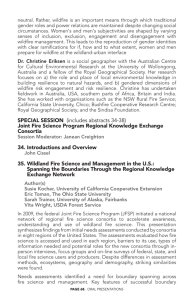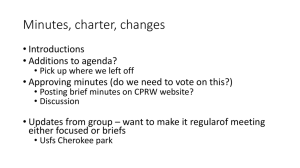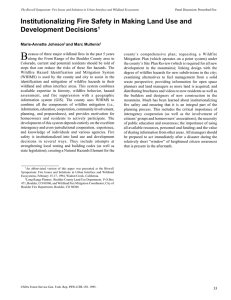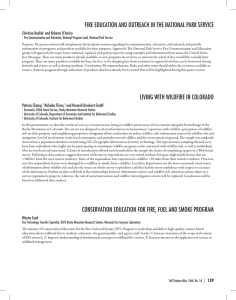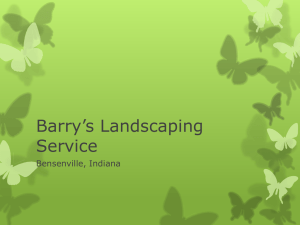Project Summary Form Id Number 2006-135
advertisement
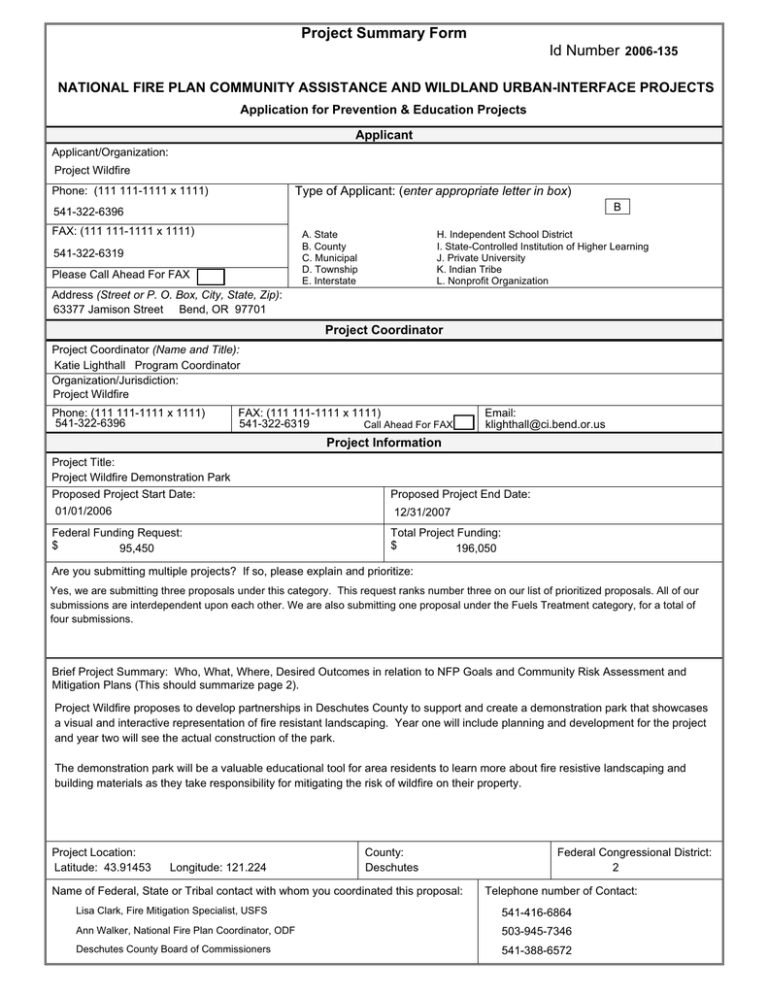
Project Summary Form Id Number 2006-135 NATIONAL FIRE PLAN COMMUNITY ASSISTANCE AND WILDLAND URBAN-INTERFACE PROJECTS Application for Prevention & Education Projects Applicant Applicant/Organization: Project Wildfire Phone: (111 111-1111 x 1111) Type of Applicant: (enter appropriate letter in box) B 541-322-6396 FAX: (111 111-1111 x 1111) A. State B. County C. Municipal D. Township E. Interstate 541-322-6319 Please Call Ahead For FAX H. Independent School District I. State-Controlled Institution of Higher Learning J. Private University K. Indian Tribe L. Nonprofit Organization Address (Street or P. O. Box, City, State, Zip): 63377 Jamison Street Bend, OR 97701 Project Coordinator Project Coordinator (Name and Title): Katie Lighthall Program Coordinator Organization/Jurisdiction: Project Wildfire Phone: (111 111-1111 x 1111) 541-322-6396 FAX: (111 111-1111 x 1111) 541-322-6319 Call Ahead For FAX Email: klighthall@ci.bend.or.us Project Information Project Title: Project Wildfire Demonstration Park Proposed Project Start Date: 01/01/2006 Federal Funding Request: $ 95,450 Proposed Project End Date: 12/31/2007 Total Project Funding: $ 196,050 Are you submitting multiple projects? If so, please explain and prioritize: Yes, we are submitting three proposals under this category. This request ranks number three on our list of prioritized proposals. All of our submissions are interdependent upon each other. We are also submitting one proposal under the Fuels Treatment category, for a total of four submissions. Brief Project Summary: Who, What, Where, Desired Outcomes in relation to NFP Goals and Community Risk Assessment and Mitigation Plans (This should summarize page 2). Project Wildfire proposes to develop partnerships in Deschutes County to support and create a demonstration park that showcases a visual and interactive representation of fire resistant landscaping. Year one will include planning and development for the project and year two will see the actual construction of the park. The demonstration park will be a valuable educational tool for area residents to learn more about fire resistive landscaping and building materials as they take responsibility for mitigating the risk of wildfire on their property. Project Location: Latitude: 43.91453 Longitude: 121.224 County: Deschutes Name of Federal, State or Tribal contact with whom you coordinated this proposal: Federal Congressional District: 2 Telephone number of Contact: Lisa Clark, Fire Mitigation Specialist, USFS 541-416-6864 Ann Walker, National Fire Plan Coordinator, ODF 503-945-7346 Deschutes County Board of Commissioners 541-388-6572 Describe project, including, but not limited to: x type of project to be delivered x project location x method of delivery x project relationship to community or natural landscape fire plans x target audience x timeliness x tools and/or skills needed to complete project x projected timelines and cost estimation x monitoring and evaluation procedures For this project, explain the level of cooperation, coordination or strategic planning, through a “Local Coordination Group.” If you haven’t worked with a local coordination group, why not? Response: Project Wildfire is the result of a Deschutes County effort to create long term wildfire mitigation strategies and provide for disaster-resistant communities. Through collaborative partnerships with public and private agencies and businesses, Project Wildfire has become the Local Coordination Group in Deschutes County that facilitates, educates, disseminates and maximizes community efforts towards effective fire planning and mitigation. Project Wildfire proposes to develop partnerships in Deschutes County to support and create a demonstration park that reveals a visual and interactive landscape utilizing fire resistive landscaping and building materials to educate homeowners who are taking action to help reduce the risk of wildfire on their own property. Our goal is to construct a useful public park in Deschutes County. We seek to demonstrate the ability to create aesthetically pleasing landscaping while improving the ability of the land to not only survive a catastrophic wildfire event, but also reduce the vulnerability of the structures. This park could be similar to the demonstration area developed in northern Klamath County as part of the Walker-Range Rural Fire Protection District office. As one of the Local Coordination Groups in Deschutes County, Project Wildfire is in a position to facilitate projects that reach thousands of residents with an educational message about wildfire prevention and preparedness. This project has also been developed in coordination with the Central Oregon Fire Leadership Council, the LCG that coordinates the National Fire Plan efforts in our area. The Project Wildfire Steering Committee recently completed an update to our business plan. In the plan, the committee strategically outlines its desire for tangible projects that educate residents about how to live with the threat of fire in the wildland urban interface. Our goal is to change attitudes and behaviors about the high risk of fire in our area by demonstrating how effective, and still beautiful, a fire-resistive landscape can be. The group agreed to pursue additional partnerships to help support the project. Our goal is to partner with organizations like Bend Metro Parks and Recreation or the High Desert Museum to direct the development and landscape design of a park. Plants and other landscaping will be labeled, and landscaping direction will be provided based on the minimum standards identified through the Senate Bill 360 process. We will use demonstration boards to identify additional measures that residents can take to reduce their risk, and also to recognize the collaborative partnerships within our community to make the park a reality. Although creating fire resistant landscaping is always an issue in the Wildland Urban Interface, this park project is timely as residents of Deschutes County address compliance with Senate Bill 360 requirements. Through partnerships, grants, volunteer and other in-kind donations from local nurseries, the cost of the actual development of the park will be shared between several organizations. The majority of funding from this grant will be utilized for project planning and development activities such as developing partnerships, locating appropriate space for the landscape park, creating a landscape design plan, etc. We expect that construction of the park will not occur until the second year. Although this park may not be located in an urban interface area or reduce hazardous fuels, it will ultimately provide concerned residents with information, tools and ideas about how to address the hazards on their own property. 1. Prevention of Wildland Urban Interface Fire (40 points) Describe how the proposal will lead to: A. Reduction of wildland urban interface fire B. Reduction of structural losses C. Homeowner action and personal responsibility to reduce fire loss of private land. Response: In order for homeowners to create fire resistant landscaping, they not only need to know what problems exist on their property, but also how to fix them and what tools are available. Both new and long term residents gain awareness of our high risk environment through a variety of avenues including the FireFree campaign, the Senate Bill 360 process, implementation of the Healthy Forest Restoration Act and of course, when wildfire threatens or strikes Central Oregon. Individual homeowners are the target for this project. As residents continue to become more educated about reducing their own risk, they seek visual representations and instruction about how to direct landscaping efforts on their property. While some residents resist the idea of fire resistant landscaping because it is perceived to be ugly, others willing to comply have no idea how to go about redesigning their property or what tools and resources exist to help them. This park will address both these areas, leading to a reduction in hazardous vegetation, in structural losses, and a decrease in the potential for wildfires to move into neighborhoods. 2. Community Participation (30 points) Detail the community participation and collaboration for this project. Define clearly why you believe your group will be successful in delivering the proposal to the target audience. How will the project be sustained or carried forward beyond project timelines? How will the project be monitored and evaluated? Response: Project Wildfire is a leading example of collaboration and community participation. We have experienced great success in facilitating on-the-ground education and mitigation projects in Deschutes County. Further collaboration will come through the development of this project, and individual community members will participate every time the park is visited. Through the knowledge and dedication of our Steering Committee and contributions from landscape designers, nurseries and community members, the demonstration park will deliver messages about fire resistant landscaping while creating a viable park from which area residents will learn and enjoy. We will internally evaluate the progress toward developing the project the first year through monthly reports to the Project Wildfire Steering Committee. Input and recommendations will be received from the group as well as from specific partners involved in the project. We will be able to make adjustments in the planning process for a successful construction outcome. Once the park is constructed in the second year of the project, the maintenance of the park will be the responsibility of the host partner. No further funding for the project will be required. We will monitor the growth and development of the landscaping to ensure its fire-resistive characteristics. The overall evaluation of the project will occur when the park is complete and we can survey visitors about the education they received and their intent to take action. 3. Partnerships (30 points) Detail the level of involvement of any local multi-agency, emergency services, non-profit coordination group, and provide a list of partners for this project with their current and expected level of involvement, including any kind of contributions or matching funds. What is the project relationship to a community risk assessment or mitigation plan? Include the name of the plan, date it was prepared, and local contact to get a copy of the plan if requested. Response: Project Wildfire is a Local Coordination Group in Deschutes County. Project Wildfire is a group comprised of 25 representatives from State, County and City fire and forest agencies, private forests and businesses, local homeowners associations and educational institutions. Through our own partners and in coordination with the Central Oregon Fire Leadership Council, we submit this proposal to further develop community partnerships to construct a community park that showcases fire resistive landscaping achievements. Project Wildfire is a working partner with local community fire planning efforts and is also tasked with completing a county wide fire plan. Contact Joe Stutler at [541] 322-7117 for information on this and other individual plans. Through this process, we have identified the need for a visual and interactive display of fire resistive landscaping techniques. Deschutes County, the City of Bend and Deschutes County Rural Fire District #2 have indicated their continued support for this project. They will provide a match for this project including office space, phone, computer and technical support. Project Work Form Tasks Time Frame Develop partnerships with organizations to host demo park. Locate appropriate space for park. Responsible Party Program Coordinator and Project Wildfire Steering Committee. Jan 2006 to July 2006 Develop partnerships to help create, design and construct demo park. Program Coordinator and Project Wildfire Steering Committee. March 2006 to Dec 2006 Oversee development and construction of park. Program Coordinator and Project Wildfire Steering Committee. Jan 2007 to Dec 2007 Project Budget Bend Fire Dept. Cost Category Description Federal Agency Applicant Nurseries, contrs. Partner 1 Partner 2 Total Partner 3 Personnel Program coordinator Subtotal $20,000 $0 $0 $0 $0 $0 $0 $0 $0 $0 $0 $20,000 $0 $0 $0 $20,000 $0 $0 $0 $0 $20,000 Fringe Benefits $0 $0 $0 $0 $0 $0 $0 $0 $0 $0 $0 $0 $0 $0 $0 $3,000 $0 $0 $0 $0 $3,000 $0 $0 $0 $3,000 $0 $0 $0 $0 $0 $0 $3,000 $0 $0 $0 $0 $0 $0 $0 $0 $0 $0 $0 $0 $0 $0 $0 $0 $0 $0 $0 $0 $15,600 $0 $0 $15,600 $15,000 $0 $0 $0 $0 $15,000 $15,000 $0 $15,600 $0 $0 $30,600 design and construction $65,000 $0 $0 $65,000 $0 $130,000 $0 $0 $0 $0 $65,000 $0 $0 $0 Subtotal $0 $65,000 $0 $130,000 Subtotal Travel workshops, tours $0 Subtotal Equipment Subtotal Supplies office, comp & support signs, id of plants Subtotal Contractual Other $0 $0 $0 $0 $0 $0 15% admin of grant OSU $12,450 $0 $0 $0 $12,450 Subtotal $12,450 $0 $0 $0 $0 $0 $12,450 $95,450 $20,000 $15,600 $65,000 $0 $196,050 $0 $0 $0 $0 $0 $0 Total Costs Project (Program) Income1 ___________________________________ 1 Program income is the gross revenue generated by a grant or cooperative agreement supported activity during the life of the grant. Program income can be made by recipients from fees charged for conference or workshop attendance, from rental fees earned from renting out real property or equipment acquired with grant or cooperative agreement funds, or from the sale of commodities or items developed under the grant or cooperative agreement. The use of Program Income during the project period may require prior approval by the granting agency.
